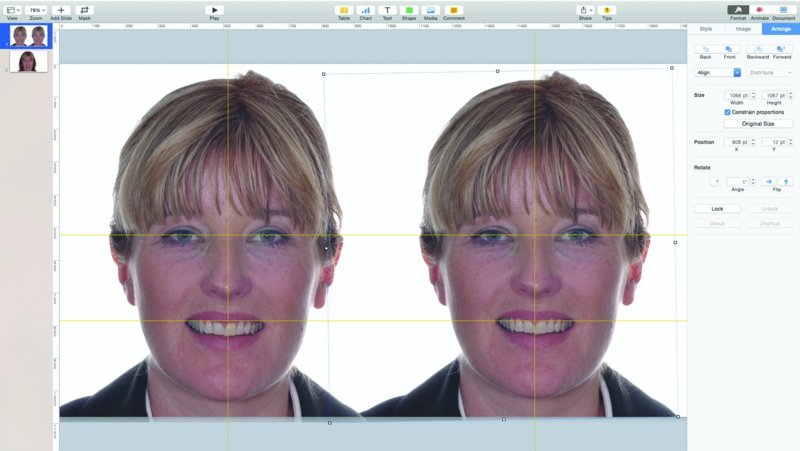Digital Smile Evaluation
Andrea Shepperson
Principles
Concepts of smile design and dento-facial aesthetics have been an integral feature of dentistry since early denture design. Essential design criteria have been developed, beginning with an evaluation of facial aesthetics and moving to dento-facial relationships. Design begins with full-face evaluations, determining where teeth should sit in the face to provide balance and harmony. Once fundamental tooth position is determined, micro-aesthetic elements are applied that consider tooth form and arrangement, tooth proportion, axial alignment, gingival scallop and colour. These universally recognised principles are well documented in both early denture and prosthodontic texts, and more recently in books and online references outlining systematic evaluation in case planning.1–5
Advances in digital photography and software functionality allow convenient and accurate conceptual evaluation of dento-facial aesthetics on a computer.
Ratios, proportions, guidelines and smile simulation are simple to convey with accuracy and become a useful and efficient tool for communication between dentist, laboratory technician and patient.6, 7
Procedures
Digital Smile Evaluation
Photography
Digital smile evaluation requires a standard series of digital photographs using a high-resolution digital camera with macro lenses. A selection of appropriate retractors and mirrors captures quality images for evaluation. The use of a black contrasting device in intra-oral views provides a dark background on which to evaluate micro-aesthetic elements and visualise lines and design guides.
Cloud-Based File Sharing
Clinicians, specialists and technicians share design information via the cloud, synchronising design updates and shared data. The result is a continuous workflow by all parties involved in the final case. Geographical location is no longer a barrier to effective communication.
Facial References
Traditional communication of facial references occurs with the use of a facebow or simple stick-bite tool to transfer vertical and horizontal reference planes to dental casts. Articulation of casts, based on these references, allows a technician to design tooth alignment relative to the face and to develop incisal or occlusal planes in reference to articulator mounting platforms, which mimic facial planes.
Digital smile evaluation uses a digital facebow – horizontal and vertical guidelines drawn on a screen with the ability to re-orientate or rotate a photograph to determine the ideal vertical and facial planes (Figure 2.5.1).7

Figure 2.5.1 The digital facebow analysis allows fine adjustment to head position to create accurate horizontal and vertical facial references
Smile design begins with full-face photographs of the patient. Standard full-face photos should include the following:
- Lips in repose with lips slightly parted
- A natural smile
- A full ‘eeee’ smile with maximum gingival display
- An optional additional full-face view with intra-oral retractors and teeth apart, to highlight undulations in the occlusal plane.
These photographs allow a number of simple facial parameters to be assessed:
- Orientation of the dental and facial midlines
- Facial proportions or thirds.
Lines can be drawn onto full-face images to provide a guide for more harmonious relationships, and these become a blueprint for the technician to align casts using a virtual or digital facebow. In its simplest form this is only a two-dimensional reference. However, advances in intra-oral scanning and interfaces between computer-aided design (CAD) technology and digital photography and smile evaluation have allowed three-dimensional referencing of virtual casts in relation to the face.
Dento-facial References
Full-face photographs also allow determination of dento-facial references. These include:
- Tooth display in repose
- Smile line and contour – the alignment of the incisal edges and cusp tips in relation to the lower lip
- Gingival display – lip position in relation to gingiva in a full smile
- Horizontal references created by incisal edges of maxillary anterior teeth (the incisal plane)
- Alterations in the occlusal plane that highlight wear patterns and over-erupted teeth.
Tracings, measurements, lines and curves provide clear visual references and detail that may be overlooked in analogue planning. Repositioning lines and curves is simple in the digital evaluation. Waxing or surgical guidelines are clearly evaluated and communicated.
Stay updated, free dental videos. Join our Telegram channel

VIDEdental - Online dental courses


